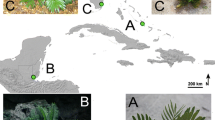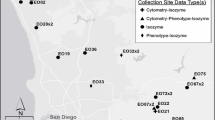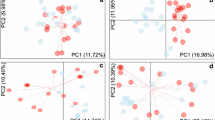Abstract
Plant conservation urgently needs a concept that would unify different aspects of population viability as parts of conservation methodology. Such unification is especially lacking for ex situ conservation. We introduce a novel conservation approach in which ex situ collections maintained in natural or semi-natural environment and preserving both neutral and adaptive genetic diversity are a part of a complementary ex situ–in situ conservation strategy. Our approach is the first that explicitly takes into account ecologically significant (i.e. adaptive) variation of plants in both ex situ and in situ conservation actions. Using this approach we provide detailed guidelines for (1) representative sampling of the populations; (2) collection maintenance; and (3) utilization for in situ actions.


Similar content being viewed by others
References
Aguilar R, Quesada M, Ashworth L, Herrerias-Diego Y, Lobo J (2008) Genetic consequences of habitat fragmentation in plant populations: susceptible signals in plant traits and methodological approaches. Mol Ecol 17:5177–5188
Allen WH (1994) Reintroduction of endangered plants. Bioscience 44:65–68
Ashton PS (1987) Biological considerations in in situ vs ex situ plant conservation. In: Bramwell D, Hamann O, Heywood VH, Synge H (eds) Botanic gardens and world conservation strategy. Academic Press, London, pp 117–130
Ashton PS (1988) Conservation of biological diversity in botanical gardens. In: Wilson EO (ed) Biodiversity. National Academy Press, Washington, pp 269–278
Barner H (1975) Identification of sources for procurement of reproductive materials. Report on FAG/DANIDA training course on forest seed collection and handling. FAO of the United Nations, Rome, pp 42–64
Barrett SC, Kohn JR (1991) Genetic and evolutionary consequences of small population size in plants: implications for conservation. In: Falk DA, Holsinger KE (eds) Genetics and conservation of rare plants. Oxford University Press, New York, pp 3–30
Benson EE (1999) Cryopreservation. In: Benson EE (ed) Plant conservation biotechnology. Taylor & Francis, London, pp 83–95
Blixt S (1994) Conservation methods and potential utilization of plant genetic resources in nature conservation. In: Begemann F, Hammer K (eds) Integration of conservation strategies of plant genetic resources in Europe. IPK and ADI, Gatersleben
Bottin L, Le Cadre S, Quilichini A, Bardin P, Moret J, Machon N (2007) Re-establishment trials in endangered plants: a review and the example of Arenaria grandiflora, a species on the brink of extinction in the Parisian region (France). Ecoscience 14:410–419
Brown ADH, Briggs JD (1991) Sampling strategies for genetic variation in ex situ collections of endangered plant species. In: Falk DA, Holsinger KE (eds) Genetics and conservation of rare plants. Oxford University Press, New York, pp 99–122
Brown ADH, Hardner CM (2000) Sampling the gene pools of forest trees for ex situ conservation. In: Young A, Boshier D, Boyle T (eds) Forest conservation genetics: principles and practice. CSIRO Publishing, Melbourne, pp 185–196
Brown ADH, Marshall DR (1995) A basic sampling strategy: theory and practice. In: Guarino L, Ramantha Rao VR (eds) Collecting plant genetic diversity: technical guidelines. CAB International Wallington, UK, pp 75–111
Burney DA, Burney LP (2007) Paleoecology and “inter-situ” restoration on Kauai, Hawaii. Front Ecol Environ 5:483–490
Cohen JI, Williams JT, Plucknett DL, Shands HL (1991) Ex situ conservation of plant genetic resources: global development and environmental concerns. Science 253:866–872
Cohrane A (2004) Western Australia’s ex situ program for threatened species: a model integrated strategy for conservation. In: Guerrant EOJ, Havens K, Maunder M (eds) Ex situ plant conservation: supporting species survival in the wild. Island Press, Washington, pp 40–66
Cohrane JA, Crawford AD, Monks LT (2007) The significance of ex situ seed conservation to reintroduction of threatened plants. Aust J Bot 55:356–361
Cranston DM, Valentine DH (1983) Transplant experiments on rare plants species from Upper Teesdale. Biol Conserv 26:175–191
Cugnac Ad (1953) Le role des jardines botaniques pour la conservation des especes menacees de disparition ou d’alteration. Ann Biol 29:361–367
Eberhart SA, Roos EE, Towill LE (1991) Strategies for long-term management of germplasm collections. In: Falk DA, Holsinger KE (eds) Genetics and conservation of rare plants. Oxford University Press, Oxford, pp 133–145
Ellstrand NC, Elam DR (1993) Population genetic consequences of small population size: implications for plant conservation. Annu Rev Ecol Syst 24:217–242
Engelmann F, Engels JMM (2002) Technologies and strategies for ex situ conservation. In: Engels J, Rao VR, Brown AHD, Jackson MT (eds) Managing plant genetic diversity. CABI Publishing, New York, pp 89–104
Etterson JR (2004) Evolutionary potential of Chamaecrista fasciculata in relation to climate change. I. Clinal patterns of selection along an environmental gradient in the Great Plains. Evolution 58:1446–1458
Falk DA (1987) Integrated conservation strategies for endangered plants. Nat Areas J 7:118–123
Falk DA (1990) Integrated strategies for conserving plant genetic diversity. Ann Mo Bot Gard 77:38–47
Fay MF (1992) Conservation of rare and endangered plants using in vitro methods. In Vitro Cell Dev Biol 28:1–4
Fay JC (1994) In what situations is in vitro culture appropriate to plant conservations? Biodivers Conserv 3:176–183
Frankel OH, Soulé ME (1981) Conservation and evolution. Cambridge University Press, New York
Given DR (1987) What the conservationist requires of ex situ collections. In: Bramwell D, Hamann O, Heywood VH, Synge H (eds) Botanic gardens and world conservation strategy. Academic Press, London, pp 103–116
Gomez-Campo C (1985) Seed banks as an emergency conservation strategy. In: Gomez-Campo C (ed) Plant conservation in the Mediterranean area. Dr. W. Junk, Dordrecht, pp 237–247
Guerrant EOJ (1992) Genetic and demographic considerations in the sampling and reintroduction of rare plants. In: Fiedler PL, Jain SK (eds) Conservation biology: the theory and practice of nature conservation, preservation and management. Chapman & Hall, New York, pp 321–344
Guerrant EOJ (1996) Designing populations: demographic, genetic and horticultural dimensions. In: Falk DA, Millar CI, Olwell M (eds) Restoring diversity. Strategies for reintroduction of endangered plants. Island Press, Washington, pp 171–207
Guerrant EOJ, Fiedler PL (2004) Accounting for sample decline during ex situ storage and reintroduction. In: Guerrant EOJ, Havens K, Maunder M (eds) Ex situ plant conservation: supporting species survival in the wild. Island Press, Washington, pp 365–386
Guerrant EOJ, Kaye TN (2007) Reintroduction of rare and endangered plants: common factors, questions and approaches. Aust J Bot 55:362–370
Guerrant EOJ, Pavlik BM (1997) Reintroduction of rare plants: genetics, demography and the role of ex situ conservation methods. In: Fiedler PL, Kareiva PM (eds) Conservation biology for the coming decade. Chapman & Hall, New York, pp 80–108
Guerrant EOJ, Raven A (2003) Supporting in situ conservation: the Berry Botanic Garden, an ex situ regional resource in an integrated conservation community. In: Smith RD, Dickie JB, Linington SH, Pritchard HW, Probert RJ (eds) Seed conservation: turning science into practice. The Royal Botanic Gardens, Kew London, pp 879–896
Guerrant EOJ, Fiedler PL, Havens K, Maunder M (2004) Revised genetic sampling guidelines for conservation collections of rare and endangered plants. In: Guerrant EOJ, Havens K, Maunder M (eds) Ex situ plant conservation: supporting species survival in the wild. Island Press, Washington, pp 419–438
Hamilton MB (1994) Ex situ conservation of wild plant species: time to reassess the genetic assumptions and implications of seed banks. Conserv Biol 8:39–49
Havens K, Vitt P, Maunder M, Guerrant EOJ, Dixon K (2006) Ex situ plant conservation and beyond. Bioscience 56:525–531
Hawkes JG (1987) A strategy for seed banking in botanic gardens. In: Bramwell D, Hamann O, Heywood VH, Synge H (eds) Botanic gardens and the world conservation strategy. Academic Press, London, pp 131–149
Hedrick PW, Kalinowski ST (2000) Inbreeding depression in conservation biology. Annu Rev Ecol Syst 31:139–162
Henderson JA (1997) The PNV model. Mt. Baker/Snoqualmie National Forests, Mountlake Terrace
Heywood V (1991) Botanic gardens and the conservation of medicinal plants. In: Akerele O, Heywood V, Synge H (eds) Conservation of medicinal plants. Cambridge University Press, Cambridge, pp 213–228
Heywood VH, Iriondo JM (2003) Plant conservation: old problems, new perspectives. Biol Conserv 113:321–335
Higgins K, Lynch M (2001) Metapopulation extinction caused by mutation accumulation. Proc Natl Acad Sci USA 98:2928–2933
Holl KD, Hayes GF (2006) Challenges to introducing and managing disturbance regimes for Holocarpha macradenia, an endangered annual grassland forb. Conserv Biol 20:1121–1131
Holland PG (1980) Transplant experiments with trout lily at Mont St. Hilaire, Quebec. J Biogeogr 7:261–267
Hufford KM, Mazer SJ (2003) Plant ecotypes: genetic differentiation in the age of ecological restoration. Trends Ecol Evol 18:147–155
Hurka H (1994) Conservation genetics and the role of botanical gardens. In: Sandlund OT, Hindar K, Brown AHD (eds) Conservation genetics. Birkhauser Verlag, Basel, pp 371–380
Husband BC, Campbell LG (2004) Population responses to novel environments: implications for ex situ plant conservation. In: Guerrant EOJ, Havens K, Maunder M (eds) Ex situ plant conservation: supporting species survival in the wild. Island Press, Washington, pp 231–266
IPGRI/FAO/FLD (2004) Forest genetic resources conservation and management. Vol. 3. Plantations and genebanks. Biodiversity International, Rome
Joshi J, Schmid B, Caldeira MC, Dimitrakopoulos PG, Good J, Harris R, Hector A (2001) Local adaptation enhances performance of common plant species. Ecol Lett 4:536–544
Keller LF, Waller DM (2002) Inbreeding effects in wild populations. Trends Ecol Evol 17:230–241
Laguna E, Deltoro VI, Pèrez-Botella J, Pèrez-Rovira P, Serra L, Olivares A, Fabregat C (2004) The role of small reserves in plant conservation in a region of high diversity in eastern Spain. Biol Conserv 119:421–426
Lande R (1993) Risks of population extinction from demographic and environmental stochasticity and random catastrophes. Am Nat 142:911–927
Lande R (1994) Risk of population extinction from new deleterious mutations. Evolution 48:1460–1469
Lande R, Barrowclough GF (1987) Effective population size, genetic variation, and their use in population management. In: Soulé ME (ed) Viable populations for management. Cambridge University Press, Cambridge, pp 87–124
Linhart YB, Grant MC (1996) Evolutionary significance of local genetic differentiation in plants. Annu Rev Ecol Syst 27:237–277
Linington SH, Pritchard HW (2001) Gene banks. In: Levin SA (ed) Encyclopedia of biodiversity. Academic Press, San Francisco, pp 165–181
Lofflin DL, Kephart SR (2005) Outbreeding, seedling establishment, and maladaptation in natural and reintroduced populations of rare and common Silene douglasii (Caryophyllaceae). Am J Bot 92:1691–1700
Lynch PT (1999) Tissue culture techniques in in vitro plant conservation. In: Benson EE (ed) Plant conservation biotechnology. Taylor & Francis, London
Marshall DR, Brown AHD (1975) Optimum sampling strategies in genetic conservation. In: Frankel OH, Hawkes JG (eds) Crop genetic resources for today and tomorrow. International Biological Programme 2. Cambridge University Press, Cambridge, pp 53–80
Maunder M, Higgens S, Culham A (2001) The effectiveness of botanic garden collections in supporting plant conservation: a European case study. Biodivers Conserv 10:383–401
Maunder M, Havens K, Guerrant EOJ, Falk DA (2004a) Ex situ methods: a vital but underused set of conservation resources. In: Guerrant EOJ, Havens K, Maunder M (eds) Ex situ plant conservation: supporting species survival in the wild. Island Press, Washington, pp 389–408
Maunder M, Hughes C, Hawkins JA, Culham A (2004b) Hybridization in ex situ plant collections: conservation concerns, liabilities, and opportunities. In: Guerrant EOJ, Havens K, Maunder M (eds) Ex situ plant conservation: supporting species survival in the wild. Island Press, Washington, pp 325–364
Mehrhoff LA (1996) Reintroducing endangered Hawaiian plants. In: Falk DA, Millar CI, Olwell M (eds) Restoring diversity. Strategies for reintroduction of endangered plants. Chapman & Hall, New York, pp 301–332
Menges ES (2008) Restoration demography and genetics of plants: when is a translocation successful? Aust J Bot 56:187–196
Menges ES, Guerrant E, Hamze S (2004) Effects of seed collection on the extinction risk of perennial plants. In: Guerrant EOJ, Havens K, Maunder M (eds) Ex situ plant conservation: supporting species survival in the wild. Island Press, Washington, pp 305–324
Millar CI, Libby WJ (1991) Strategies for conserving clinal, ecotypic, and disjunct population diversity in widespread species. In: Falk DA, Holsinger KE (eds) Genetics and conservation of rare plants. Oxford University Press, New York, pp 149–170
Morton JK (1982) Preservation of endangered species by transplantation. Can Bot Assoc Bull 15:32
Newman D, Pilson D (1997) Increased probability of extinction due to decreased genetic effective population size: experimental populations of Clarkia pulchella. Evolution 51:354–362
Newman D, Tallmon DA (2001) Experimental evidence for beneficial fitness effects of gene flow in recently isolated populations. Conserv Biol 15:1054–1063
Pavlik BM (1996) Defining and measuring success. In: Falk DA, Millar CI, Olwell M (eds) Restoring diversity. Strategies for reintroduction of endangered plants. Island Press, Washington, pp 127–155
Pavlik BM (1997) Perspectives, tools, and institutions for conserving rare plants. Southwest Nat 42:375–383
Prance GT (1997) The conservation of botanical diversity. In: Maxted N, Ford-Lloyd BV, Hawkes JG (eds) Plant genetic conservation. The in situ approach. Chapman & Hall, London, pp 3–14
Roberts EH (1991) Genetic conservation in seed banks. Biol J Linn Soc 43:23–29
Sarasan V, Cripps R, Ramsay MM, Atherton C, McMichen M, Prendergast G, Rowntree JK (2006) Conservation in vitro of threatened plants—progress in the past decade. In Vitro Cell Dev Biol 42:206–214
Schaal B, Leverich WJ (2004) Population genetic issues in ex situ plant conservation. In: Guerrant EOJ, Havens K, Maunder M (eds) Ex situ plant conservation: supporting species survival in the wild. Island Press, Washington
Schemske DW, Husband BC, Ruckelshaus MH, Goodwillie C, Parker I, Bishop JG (1994) Evaluating approaches to the conservation of rare and endangered plants. Ecology 75:584–606
Schoen DJ, Brown ADH (2001) The conservation of wild plant species in seed banks. Bioscience 51:960–966
Smith RD, Hawtin G (2003) The future of seed banks. In: Smith RD, Dickie JB, Linington SH, Pritchard HW, Probert RJ (eds) Seed conservation: turning science into practice. The Royal Botanic Gardens, Kew, pp 981–992
Snaydon RW, Davies MS (1976) Rapid population differentiation in a mosaic environment. IV. Populations of Anthoxanthum odoratum at sharp boundaries. Heredity 37:9–25
Soulé M (1980) Thresholds for survival: maintaining fitness and evolutionary potential. In: Soulé M, Wilcox BA (eds) Conservation biology: an evolutionary-ecological perspective. Sinauer Associates, Sunderland, pp 151–169
Soulé M, Simberloff D (1986) What do genetics and ecology tell us about the design of nature reserves? Biol Conserv 35:18–40
Tallmon DA, Luikart G, Waples RS (2004) The alluring simplicity and complex reality of genetic rescue. Trends Ecol Evol 19:489–496
Theilade I (2004) The role of ex situ conservation of trees in living stands. In: Luoma-aho T, Hong LT, Ramanatha Rao V, Sim HC (eds) Forest genetic resources conservation and management. Proceedings of the Asia Pacific Forest Genetic Resources Programmme (APFORGEN) Inception Workshop, Kepong, Malaysia, 15–18 July, 2003 IPGRI-APO, Serdang, Malaysia, pp 316–325
Uma Shaanker R, Ganeshaiah KN (1997) Mapping genetic diversity of Phyllanthus emblica: forest gene banks as a new approach for in situ conservation of genetic resources. Curr Sci 73:163–168
Uma Shaanker R, Ganeshaiah KN, Nageswara Rao M, Ravikanth G (2001) A new approach to conservation of genetic resources of forest trees: promise and processes. In: Uma Shaanker R, Ganeshaiah KN, Bawa KS (eds) Forest genetic resources: status, threats and conservation strategies. Oxford and IBH Publishing Co., pp 263–271
Uma Shaanker R, Ganeshaiah KN, Nageswara Rao M, Ravikanth G (2002) Forest gene banks – a new integrated approach for the conservation of forest tree genetic resources. In: Engels JMM, Brown AHD, Jackson MT (eds) Managing plant genetic resources. CABI Publishing, Nosworthy, UK, pp 229–235
Volis S, Mendlinger S, Ward D (2002) Differentiation in populations of Hordeum spontaneum along a gradient of environmental productivity and predictability: life history and local adaptation. Biol J Linn Soc 77:479–490
von Bothmer R, Selberg O (1995) Strategies for the collecting of wild species. In: Guarino L, Ramantha Rao VR (eds) Collecting plant genetic diversity: technical guidelines. CAB International Wallington, UK, pp 93–111
Walters C (2004) Principles for preserving germplasm in gene banks. In: Guerrant EOJ, Havens K, Maunder M (eds) Ex situ plant conservation: supporting species survival in the wild. Island Press, Washington, pp 113–138
White PS, Walker JL (1997) Approximating nature’s variation: selecting and using reference information in restoration ecology. Restor Ecol 5:338–349
Wyse Jackson P (2001) An international review of the ex situ plant collections of the botanic gardens of the world. Bot Gard Conserv News 3:22–33
Acknowledgments
We would like to thank Dror Hawlena, Yuval Sapir, Yehoshua Shkedy and Margareta Walczak for helpful discussions and two anonymous reviewers for their comments and suggestions that helped to improve the manuscript.
Author information
Authors and Affiliations
Corresponding author
Rights and permissions
About this article
Cite this article
Volis, S., Blecher, M. Quasi in situ: a bridge between ex situ and in situ conservation of plants. Biodivers Conserv 19, 2441–2454 (2010). https://doi.org/10.1007/s10531-010-9849-2
Received:
Accepted:
Published:
Issue Date:
DOI: https://doi.org/10.1007/s10531-010-9849-2




